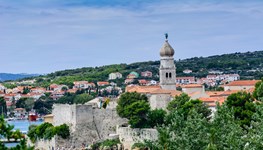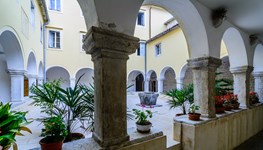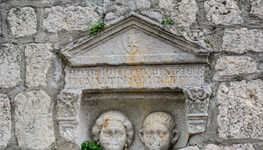City Walls

The Krk city walls are a multi-level matter, interesting and challenging both to the experienced eye of an expert and the intrigued eye of an inhabitant or a visitor. Although the cities on our coast are relatively often surrounded by walls, rarely can a city brag with the well preserved entire perimeter of the city wall, which in certain places is up to two thousand years old. We know that the prehistoric city Curicta (Krk) was fortified by walls. This is witnessed by the inscription from the 1 ...
Wash trough (krušija)

Potable water is extremely significant to the city, so it is no wonder that this spring of potable water has been mentioned ever since the 13th century. In 1554, the provveditore Mapheo Girardo wrote to the Venetian Doge praising the source, emphasizing how it could satisfy the needs of all the armies in the world. However, Krušija is also related to two problems, both referring to the location of the source. First of all, the source is situated outside the city walls, which means that in ...
The Chapel of St Josip

The chapel of St Josip (Joseph) is situated on the main city street (decumanus). Originally the chapel was dedicated to Our Lady of Mount Carmel. It was mentioned for the first time in 1672. It is very well preserved and it may be assumed it was built during the 17th century, which is indicated by the preserved altar from the same period, the work of an unknown master.There were several chapels in the Krk city centre, most of which were not preserved until today. The reason lies in the death of ...
Church and monastery of St Francis

Ever since the 13th century, various documents, wills and statutes mention the monastery and the church of St Francis in Krk. Only the written records from the 15th century mention the location, because the document says the church is very near the Benedictine monastery.The church of St Francis is a one-nave structure with a semicircular apse and a Gothic style roof. It is traditionally oriented west – east. Considering that the church sacristy contained frescos from an earlier period, it ...
A fragment from a Roman tombstone

A Roman tombstone (stella) built in as a spolium on a hexagonal tower in the walls of Krk, located near the Small Gate on the quay. The stella is located 5.5 m above the ground, it is 80 cm high and 75 cm wide. It is made of soft porous limestone. It consists of an edicule with the heads of the deceased, a man and a woman, carved in stone. This central rectangular area is framed with two vertical Corinthian pilasters. This is followed by an elongated rectangular frieze, with subsequently written ...
Frankopan Castle

On the square Kamplin, opposite of the Krk cathedral, near the bishop’s palace, there is the old Frankopan castle. It was the central and final line of city defence. It was made during several construction operations, from the 12th until the end of the 18th century. The oldest architectural element of the castle is the square tower – Frankopan tower and a court. It is known that the tower was completed in 1191, as this is witnessed by the Latin inscription in the semi-lunette above t ...
